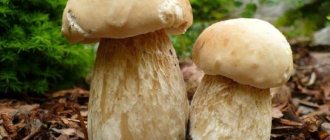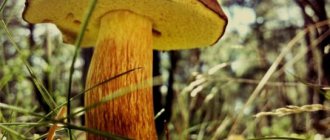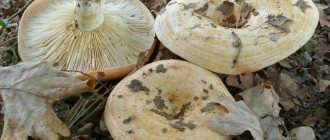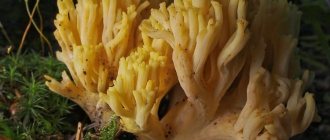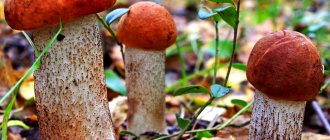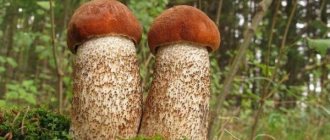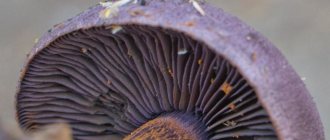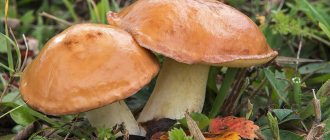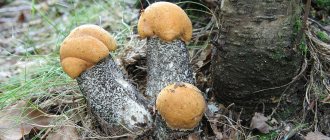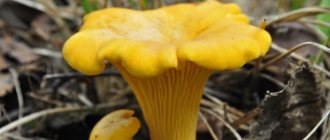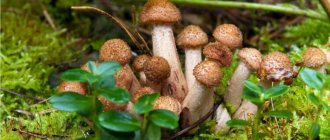Tell children about mushrooms – Tell children about mushrooms – Page 2
Details Category: Find out!
In English-speaking countries, this mushroom is called “slippery Jack”, in Germany – “butter mushroom”, in the Czech Republic – “butter mushroom”. In some butter mushrooms, the tubular layer is covered from below with a thin film. It is called a private veil. As the mushroom matures, it is destroyed, its remainder can be found on the stem in the form of a filmy ring. The flesh of butternut squash is yellowish, slightly pinker when cut.
It has a pleasant soft pine aroma. In pine and mixed forests, boletus grows in large families almost all summer until the autumn frosts. Butterflies are common in Eurasia, America, and Australia. The most common type of butterfly is true, granular, and larch. The butterfly is a noticeable mushroom, the height of the stem is 3–8 cm, and the width of the cap is 5–10 cm.
Most types of buttermilk practically do not differ from each other in taste. Butternuts are usually not dried because after drying they become rock hard.
They fry or prepare soup from summer harvests, but autumn harvests are better suited for pickling and pickling, because they are denser and more elastic, and do not spoil for a long time.
The genus Shrovetide includes two more types of mushrooms: goat mushroom and pepper mushroom. The goat is edible, but of low quality. Pepper mushroom has a bitter taste, so it is not usually collected.
Some fans use it as a seasoning. The lamb mushroom is very similar to the butter dish. But the bottom of the oiler's cap is light yellow, and the lamb's cap is brick red.
RIDDLE The little boy is standing - His cap is dirty.
Honey fungus
Honey mushroom spores can affect about 200 species; birch and spruce wood are favorable for them. Honey mushrooms prefer to settle in old birch forests, where there are a lot of dry birches and old stumps. The cap of the real honey mushroom has a diameter of up to 12 cm. At first it is convex, later flat with a tubercle in the middle, thin-fleshy, brownish, with small scales. The white pulp has a pleasant mushroom smell.
The leg is thin, up to 15 cm long. Light on top, brownish-brown below, with a white ring. The son yelps again: “I came across a stump, covered in some kind of mushrooms!” - Well, Vanyushka, well done! - My father was jealous. - Collect them. Nice guys, Sweet honey mushrooms. YU.
Chichev Honey fungus is a generally recognized edible mushroom, but not everyone knows that in its raw form it is poisonous, so before eating it must be boiled well - for at least 30 minutes. In some countries, honey fungus is considered inedible.
Honey mushrooms accumulate a lot of copper and zinc. To satisfy the daily need for these elements, a person only needs to eat 100 g of honey mushrooms. At the end of September, when the mushroom season ends, you can find winter honey fungus, or winter mushroom, in the forests. It grows in colonies on stumps, dead wood, and living deciduous trees. The mucous cap is 3–8 cm in diameter, yellow or brown.
Not all honey mushrooms are edible. There are two poisonous types of false mushrooms: gray-yellow and brick-red. Gray-yellow false honey fungus often grows together with real honey mushrooms. Their poisonous counterparts have yellow caps with a dark spot in the center.
The most reliable way to determine whether honey mushrooms are poisonous or not is to look at the color of their spores. To do this, take a napkin and rub it along the bottom of the mushroom cap. If the napkin turns green, it means the honey fungus is poisonous. Edible honey mushrooms have white or brownish-brown spores.
RIDDLES Friendly brothers live on a tree stump, they lead a round dance.
Aspen Boletus
I am growing in a red cap Among the aspen roots, You will recognize me a mile away, I am called an aspen boletus. The boletus is common in the forests of the Northern Hemisphere. It is also called redhead, or simply aspen. Common names: obabok, vanka-vstanka.
The cap of the boletus is spherical, with a diameter of 4 to 30 cm, red, yellowish, orange, gray or white. The bottom of the cap is finely porous, from white to dirty brown. The length of the leg can reach 20 cm.
It has oblong black scales. The flesh at the break is initially pinkish, greenish or bluish, but it quickly darkens. When dried and cooked, the mushroom turns black. Boletuses are suitable for food even without prior boiling.
They are fried, salted, pickled and dried.
Just a mushroom picker's hat - Like a beacon for a sailor.
Preparation of boletus mushrooms and cooking recipes
You can do whatever you want with boletus mushrooms. These mushrooms are dried, salted, pickled, fried with potatoes, and frozen. First, they need to be thoroughly cleaned.
- Drying . You need to choose large mushrooms. No need to wash, just wipe with a damp cloth. Cut the cap and stem into strips, about 1 cm thick. Place on a mesh. Small mushrooms – these can be dried whole and look amazing in soup. If there is no drying, then simply expose it to dry, hot weather; the process will not be quick, it may take a week. But the result will be a natural product, dried in a natural way. In bad weather, you can bring it into a well-ventilated area. This product in dried form is unique. The soup made from these mushrooms turns out rich and aromatic. This result cannot be achieved with fresh mushrooms.
- Freezing . The mushrooms must be thoroughly washed, cut and boiled in a saucepan for 40 minutes. Drain the water using a colander, cool, portion into bags and freeze. Can be stored for no more than two years.
- Salted boletus . Rinse the caps thoroughly and boil for 20 minutes. Place in a container, sprinkle with salt, place horseradish leaves and dill on top. Pour boiled water. You will need 2 cups of salt per bucket. Consume this snack no sooner than after a week, but you should not keep it for more than a month. The brine may darken, do not be alarmed.
- Pickled boletus . Wash the mushrooms and cut off the caps. There are housewives who have waste-free production, and they even scrape the legs, freeing them from scales. Boil the mushrooms for about 35 minutes, add spices. Everything here is to taste: salt, pepper, seasonings, bay leaf. Boil for another 5 minutes. Pour into jars and roll up. If you don’t want to get mushrooms in dark brine, you need to boil the mushrooms for 30 minutes and drain the water. Prepare the marinade, place the mushrooms in it and simmer for 10 minutes.
- Mushroom caviar . This is a very tasty and healthy dish. In addition to mushrooms, caviar contains many healthy vegetables. Wash the mushrooms, boil them, and grind them through a meat grinder. Separately fry onions, carrots, bell peppers. After frying, also pass through a meat grinder, combine with mushrooms and simmer for 20 minutes. Add spices to taste. Roll up.
- Boletus salad . Boil the mushrooms, cool. Cut into small pieces. Cut the pickled cucumber and boiled chicken breast into cubes. Mix with mushrooms, add mustard, season with mayonnaise and add salt. Celery – will add piquancy to the dish, but this is not a necessary product.
A story about the boletus mushroom for children - Teacher's Guide
Mushrooms, unlike plants, do not contain the pigment chlorophyll, which gives green leaves and extracts nutrients from carbon dioxide.
In addition, this group of living organisms vitally needs moisture, so they are not able to exist where there is no liquid.
Mushrooms are an essential component of the digestive system of herbivores. They play a very important role in the life of not only animals, plants, but also humans.
Next we will talk mainly about cap mushrooms.
Scheme of the structure of a cap mushroom
The fruiting bodies are made up of intertwined threads called “hyphae.” If you turn the mushroom over and look at the cap from below, you will notice that some mushrooms have thin plastics there (these are lamellar mushrooms), while others are like a sponge (sponge mushrooms).
It is there that the spores (very small seeds) necessary for the reproduction of the fungus are formed.
The fruiting body makes up only 10% of the mushroom itself. The main part of the fungus is the mycelium; it is not visible to the eye because it is located in the soil or tree bark and is also an interweaving of hyphae.
Another name for mycelium is “mycelium”. A large area of the mycelium is necessary for the mushroom to collect nutrients and moisture.
In addition, it attaches the fungus to the surface and promotes further spread over it.
Edible mushrooms
The most popular edible mushrooms among mushroom pickers include: porcini mushroom, boletus, boletus, butterfly, moss fly, honey fungus, milk mushroom, russula, chanterelle, saffron milk cap, and trumpet mushroom.
Porcini
Porcini mushroom (boletus) is loved by mushroom pickers for its unsurpassed taste and aroma. It is very similar in shape to a barrel. The cap of this mushroom is pillow-shaped and pale to dark brown in color. Its surface is smooth.
The pulp is dense, white, odorless and has a pleasant nutty taste. The stem of the porcini mushroom is very voluminous, up to 5 cm thick, white, sometimes beige in color. Most of it is underground.
This mushroom can be collected from June to October in coniferous, deciduous or mixed forests and its appearance depends on where it grows. You can eat white mushroom in any form.
Common boletus
The common boletus (boletus) is also a rather desirable mushroom for mushroom pickers. His hat is also pillow-shaped and colored either light brown or dark brown. Its diameter is up to 15 cm. The flesh of the cap is white, but may turn slightly pink when cut.
The length of the leg is up to 15 cm. It widens slightly downward and has a light gray color with brown scales. The boletus grows in deciduous and mixed forests from June to late autumn. He loves light very much, so most often he can be found on the edges.
Boletus can be consumed boiled, fried and stewed.
Boletus
The boletus (redhead) is easily recognized by the interesting color of its cap, reminiscent of autumn foliage. The color of the cap depends on the place of growth. It varies from almost white to yellow-red or brown. At the point where the flesh breaks, it begins to change color, darkening to black.
The leg of the boletus is very dense and large, reaching 15 cm in length. In appearance, the boletus differs from the boletus in that it has black spots drawn on its legs, as if horizontally, while the boletus is more vertical. This mushroom can be collected from the beginning of summer until October.
It is most often found in deciduous and mixed forests, aspen forests and small forests.
Oil can
The oil can has a fairly wide cap, up to 10 cm in diameter. It can be colored from yellow to chocolate, and has a convex shape. The skin can be easily separated from the flesh of the cap and it can be very slimy and slippery to the touch. The pulp in the cap is soft, yellowish and juicy.
In young butterflies, the sponge under the cap is covered with a white film; in adults, it leaves a skirt on the leg. The leg has the shape of a cylinder. It is yellow at the top and may be slightly darker at the bottom. Butterwort grows in coniferous forests on sandy soil from May to November.
It can be consumed pickled, dried and salted.
Kozlyak
The goat is very similar to the old oil can, but its sponge under the cap is darker, with large pores and there is no skirt on the leg.
Mosswort
Moss mushrooms have a cushion-shaped cap with velvety skin ranging from brown to dark green. The leg is dense, yellow-brown. The flesh may turn blue or green when cut and has a brown color. The most common are green and yellow-brown moss mushrooms.
They have excellent taste and can be consumed fried or dried. Before eating it, be sure to clean the cap. Moss mushrooms grow in deciduous and coniferous forests of temperate latitudes from mid-summer to mid-autumn.
Dubovik
Dubovik grows mainly in oak forests. In appearance, the shape resembles a porcini mushroom, and the color resembles a moss mushroom. The surface of the cap of young mushrooms is velvety; in damp weather it can be mucous. When touched, the cap becomes covered with dark spots.
The flesh of the mushroom is yellowish, dense, red or reddish at the base of the stem, turns blue when cut, then turns brown, odorless, mild taste. The mushroom is edible, but it is easily confused with inedible ones: satanic and gall mushrooms. If part of the leg is covered with a dark net, it is not oak, but its inedible double.
In olive-brown oak, the flesh immediately turns blue when cut, while in its poisonous counterpart it slowly changes color, first to red, and then turns blue.
Among the sponge mushrooms, only the gall mushroom and the satanic mushroom are poisonous; they look like white mushrooms, but immediately change color when cut, and the pepper mushroom is not edible, because it is bitter; more about them below.
But among the agaric mushrooms there are many inedible and poisonous ones, so the child should remember the names and descriptions of edible mushrooms before going on a “quiet hunt”.
Honey fungus
Honey fungus grows at the base of trees, and meadow honey fungus grows in meadows. Its convex cap, up to 10 cm in diameter, is yellowish-brown in color and looks like an umbrella. The length of the leg is up to 12 cm. In the upper part it is light and has a ring (skirt), and at the bottom it acquires a brownish tint. The pulp of the mushroom is dense, dry, with a pleasant smell.
Autumn honey fungus grows from August to October. It can be found at the base of both dead and living trees. The cap is brownish, dense, the plates are yellowish, and there is a white ring on the stem. Most often it is found in birch groves. This mushroom can be eaten dried, fried, pickled and boiled.
Summer honey fungus, like autumn honey fungus, grows on stumps all summer and even in autumn. Its cap along the edge is darker than in the middle and thinner than that of the autumn honey fungus. There is a brown ring on the stem.
Russula
Russulas have a round cap with easily peelable skin at the edges. The cap reaches 15 cm in diameter. The cap can be convex, flat, concave or funnel-shaped.
Its color varies from red-brown and blue-gray to yellowish and light gray. The leg is white, fragile. The flesh is also white. Russula can be found in both deciduous and coniferous forests. They also grow in the birch park and on the river bank.
Chanterelle
Chanterelle is an edible mushroom that is pleasant in appearance and taste. Its velvety hat is red in color and resembles a funnel shape with folds along the edges. Its flesh is dense and has the same color as the cap.
The cap smoothly transitions into the leg. The leg is also red, smooth, and tapers downwards. Its length is up to 7 cm. The chanterelle is found in deciduous, mixed and coniferous forests. It can often be found in moss and among coniferous trees. It grows from June to November.
You can use it in any form.
Gruzd
The breast has a concave cap with a funnel in the center and wavy edges. It is dense to the touch and fleshy. The surface of the cap is white and can be covered with fluff; it can be dry or, on the contrary, slimy and wet, depending on the type of milk mushroom. The pulp is brittle and when broken, white juice with a bitter taste is released.
Depending on the type of milk mushroom, the juice may turn yellow or pink when scraped. The leg of the milk mushroom is dense and white. This mushroom grows in deciduous and mixed forests, often covered with dry foliage so that it is not visible, but only a mound is visible. It can be collected from the first summer month to September. Milk mushrooms are well suited for pickling. Much less often they are fried or consumed boiled.
The breast can also be black, but the black tastes much worse.
Volnushka
Volnushki are distinguished by a small cap with an indentation in the center and a beautiful fringe along the slightly folded edges. Its color varies from yellowish to pink. The pulp is white and dense. This is a conditionally edible mushroom.
The juice has a very bitter taste, so before cooking this mushroom, it needs to be soaked for a long time. The leg is dense, up to 6 cm in length. Volnushki love damp areas and grow in deciduous and mixed forests, preferring birch trees. They are best harvested from August to September.
Volnushki can be eaten salted and pickled.
Ryzhik
Saffron milk caps are similar to saffron milk caps, but larger in size, they do not have a fringe along the edges, they are light orange in color, and the flesh when cut is also orange, turning green along the edges. The mushroom does not have bitter juice, so it can be cooked immediately without soaking. The mushroom is edible. Ryzhiki are fried, boiled and pickled.
Champignon
Champignons grow in the forest, in the city, and even in landfills and basements from summer to autumn.
While the mushroom is young, its cap has the shape of a half ball of white or grayish color, the reverse side of the cap is covered with a white veil.
When the cap opens, the veil turns into a skirt on a leg, exposing gray plates with spores. Champignons are edible, they are fried, boiled, pickled without any special pre-treatment.
Violin
A mushroom that squeaks slightly when you run a fingernail over it or when the caps are rubbed, many call it a squeaky mushroom. It grows in coniferous and deciduous forests, usually in groups.
The violin is similar to a milk mushroom, but unlike the milk mushroom, its plates are cast in a yellowish or greenish color, and the cap may also not be pure white, moreover, it is velvety. The flesh of the mushroom is white, very dense, hard, but brittle, with a faint pleasant odor and a very pungent taste. When broken, it secretes a very caustic white milky juice.
False boletus
General distinctive features of boletus
The variety of this group of mushrooms is the safest. However, when picking, inexperienced mushroom pickers often have doubts about how not to make a mistake and bring home a false mushroom.
Regardless of the type of boletus, its leg has the shape of a cylinder, but only in young individuals. With growth, the leg increases, and the cap, on the contrary, stops growing. It seems that the mushroom is of a disproportionate, disturbed shape. In very mature mushrooms, the cap grows and reaches 20 cm in diameter. It is pleasant to the touch - velvety and dry. On the inside of the cap there is a tubular layer. Depending on ripeness, they have a white or grayish tint, which turns black when pressed.
The leg is velvety and slightly rough to the touch. Its distinctive feature is the presence of scales. They form as the fungus grows. In a damaged area, the real boletus shows metamorphosis: first it turns blue, then acquires a black color. This is the main distinguishing feature.
Reading texts about mushrooms
Details Galina Category: Reading
For children who have recently learned to read, various educational stories, including ones about mushrooms, are useful. They are easy to understand. They are accompanied by questions about the text, riddles, and poems about a specific mushroom.
You can perform different exercises with them:
This turns out to be a reading trainer. After reading and completing the tasks, it is useful to draw pictures on the theme “In the forest.” It’s not enough to just read and show pictures. Children definitely need to consolidate their knowledge in activities. Then this knowledge will remain in your head for a long time. Nothing special, just draw, sculpt, make appliqué, etc.
Why do we need answers to the textbook “Russian Language”, grade 3, part 1 by Klimanova, Babushkina
The child is often unsure of himself. This happens with parents too. And then you sit together and puzzle over whether everything was done correctly or incorrectly, look for every word in the dictionaries. We can offer you more than dictionaries. Checking with the correct answers will allow you to quickly understand whether something needs to be corrected, or whether the student himself did an excellent job. This will make your life calmer and happier, you will become more confident in your strengths and abilities. And if you find a mistake, work through it and correct it in time before the teacher checks. Of course, we want to warn again and again against thoughtless cheating, which can lead to disastrous consequences, because no one has canceled independent work and tests, and at the end of the year, the children will have a test in the Russian language, for which they also need to prepare.
Boletus - description, what it looks like, where it grows, varieties, photos and videos
Boletus - description, what it looks like, where it grows, varieties, photos and videos
Boletus is one of the most common and sought after edible mushrooms. It is known for its attractive appearance, large size, high nutritional value and good taste. What does boletus look like, when does it grow and where is the best place to look for it?
What does a boletus look like?
If the mushroom is young, then its cap has a hemispherical shape. It wraps the leg tightly. With age, it becomes convex, pillow-shaped, and then completely straightens.
The skin is usually impossible to remove. It is dry to the touch, sometimes velvety. The leg is club-shaped (thick at the bottom, thin at the top). It grows up to 22 cm. The leg itself is light, but covered with numerous dark scales.
Tubular layer of boletus
The spore-bearing layer of boletus is tubular. Its thickness is about 1-3 cm. The color is usually white, yellow, gray or brownish. The spore powder is brown or olive-brown in color.
The cap flesh is dense, elastic and fleshy. The stalk is characterized by a longitudinal arrangement of fibers. The pulp is white, but if damaged it quickly turns blue, and, after some time, turns black.
Why is the boletus called that?
The Latin name for the genus of mushrooms is Leccinum (they also include boletus mushrooms). Boletus got its name by analogy with boletus - due to the ability of the fungus to form stable mycorrhiza with aspen. However, its different species also grow near other trees.
Source
Similar species
The red boletus has a number of related varieties:
- Boletus yellow-brown.
As its name suggests, it differs in color, which is more orange. Such mushrooms can often be found near birch trees. A pink color appears on the cut, then blue, sometimes greenish. The mushroom is edible.
- White boletus.
When young, the caps of such mushrooms are white, then turn brown. When cut, it first turns blue, then black. Edible too. Grows next to conifers.
1- Boletus yellow-brown. 2- White boletus.
- Oak obabok.
Grows among oak trees. The color of the cap is brownish, and the leg is covered with reddish scales. Edible.
- Colored-legged boletus.
The cap of these mushrooms is pink and the stem is yellow. These mushrooms grow mainly in summer, which is why they are often wormy. Edible.
1- Oak obabok. 2- Colored-legged boletus.
- Redhead pine.
Edible, grows among pine trees. It has a bright crimson cap.
- Black-scaled boletus.
It has pronounced black scaly growths on the stalk. The hat is bright red. When cut, the stem turns purple. Also edible.
- Spruce redhead.
It is distinguished by a very rough cap of a brownish color. Usually grows in spruce trees. Edible.
1- Pine redhead. 2- Black-scaled boletus. 3- Spruce redhead.
All of these species are non-toxic and quite edible. But there are also mushrooms that can be confused with boletus and have inedible properties. This is a gall mushroom. From a distance it looks slightly similar to the redhead, but upon closer inspection it is different. It is browner, its cap is slightly different in shape from the boletus (it has a cushion shape), and the leg is often curved. When cut, this mushroom turns pink and then turns brown. The mushroom is non-poisonous, but inedible due to its bitter taste.
Description of mushrooms
Real honey fungus
Common boletus
The mushroom is also useful for birch. Its outer free hyphae spread widely in the soil from the root, replacing root hairs. Free hyphae of the fungus receive water, mineral salts, and soluble organic substances from the soil, which are not only used by the fungus to build mycelium and fruiting bodies, but also enter the root of the tree.
The boletus is popularly called a black mushroom or black mushroom, since the mushroom turns black when dried.
Red boletus
For a mushroom picker, it doesn’t really matter which boletus you put in the basket: red or yellow-brown. Both are equally delicious. But for mycologists, the differences between these mushrooms are of fundamental importance.
Russula blue-yellow
Russula blue-yellow is distributed mainly in humid pine-birch forests. Unlike other varieties of russula, this mushroom is quite rare, and only in the Far East is it always found in large quantities. Mushroom pickers collect russula due to the lack of other mushrooms, but this is not due to the fact that the mushroom is tasteless, but to its extreme fragility.
You need to place the russula in the basket very carefully, otherwise you will only bring home fragments.
Unlike its “brothers,” this variety of russula often forms mycorrhiza with oak and hornbeam, which is observed, in particular, in the Caucasus. In other areas, russula are located randomly.
The blue-yellow russula is close in appearance to the gray russula, which is characterized by a yellow-brown, reddish-orange or yellowish-orange color of the cap. Graying russula forms mycorrhiza with pine.
Of all the russulas, the most delicious is considered to be the greenish russula, which has a gray-green or bluish-green cap. The pulp of this mushroom has a weak pungent taste or is not pungent at all, so the mushroom can be used not only for pickling or pickling, but also for frying.
Interesting Facts
Red boletus is characterized by a number of interesting features:
- The broth made from this mushroom is not inferior in nutritional value to beef broth.
- You should not collect overgrown mushrooms, as they have already accumulated a lot of harmful substances.
- Boletus dishes are a delicacy for weddings in some areas of North America.
- If you plan to dry boletus mushrooms, then they cannot be washed, since they instantly absorb water.
Boletuses should not be given to children due to the immaturity of their digestive tract, as well as to allergy sufferers due to the unpredictability of the body's reaction to mushrooms. Also, pregnant and lactating women should not consume mushrooms, in particular boletus.
Comparative characteristics
Young boletuses and boletuses are often confused even by experienced mushroom pickers. Not only do they belong to the same genus Leccinum, but they also look approximately the same. Differences appear during the growth process. Confusion is not dangerous, because both mushrooms are classified as edible.
The table will help you remember the differences between them:
These mushrooms have the same ripening period: it begins with the arrival of summer and lasts until the end of autumn. Boletuses bear fruit in three stages. The first occurs in June - July, then several weeks in mid-summer, and the longest last stage, which begins at the end of August and lasts until the onset of cold weather.
A characteristic feature of boletus is irregular fruiting. There are seasons when the yield is very high, followed by a dormant period.
